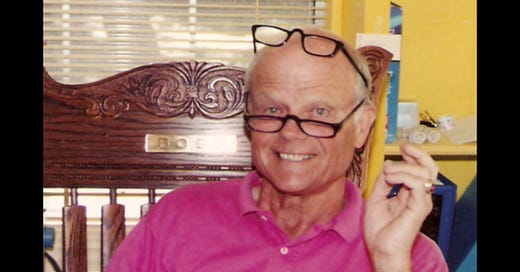Chapter 12: an arena of proof
The end result was a total surprise—
a system devised not on theory
but on results was created, and it works.
John, 1994
As John continually solidified his philosophy and framework for teaching practices of Saxon Mathematics which could be used by his sales representatives, he figured it was time for a full press on his competitors to show proof of their own products’ successes. He had already been insisting repeatedly in writing and in person that, “Mathematics is an arena of proof.” He had proven the results of his own program.
John said to his opponents, “I want to see measurable results in student achievement in mathematics evidenced by increased scores on standardized tests. I want to see dramatic gains in the number of seniors enrolled in academic math courses. I want to see measurable decreases in the number of students who give up on academic math and are in dumb-dumb courses such as basic math, consumer math, or fundamentals of math.”1
While asking for competitors’ research results, usually in his full-page advertisements, John kept pushing for more data about his own program from schools and groups using Saxon materials. He delighted in publishing those success stories in bold, capitalized headlines in his ads.
With regard to scientific research methods, he said, “I decided to throw out all theory and scram around until I found things that worked. Thus, the genesis of these books was totally eclectic. I tried everything and if something worked, I kept it. If it did not work, it was discarded. The end result was a total surprise—a system devised not on theory but on results was created, and it works!”
While John had used real research to prove his own program worked, one that was wholly-conceived, designed and produced by him, the NCTM crowd had used others’ “research” to build their amalgamated curriculum. His work was truly a result of pure “creative thinking.” As a new and raw product, it could be tested and assessed. Its results would rise or fall on him alone. The NCTM program was a cut-and-paste effort that conjoined numerous ideas and philosophies, some of which may had been proven in a laboratory setting but which, when put together, created a field of unmeasured limits.
It is therefore understandable why the NCTM curriculum later became dubbed “a mile wide and an inch deep.” Measuring the impact, or getting definitive results, of such a wide program would, naturally, be impossible. But that would work in the NCTM’s favor.
There was, during John’s time, an unrecognized truth in the world of education “theories.” For education researchers, a theory was based on any speculation, contemplation, conjecture or hypothetical situation. Actions could be implemented based simply on a “theory” and there was no need to prove the theory’s validity, especially through “peer review,” before it was adopted for widespread use.
For individuals in science, a theory uses a set of facts, propositions, or principles, analyzed in their relationship to one another to explain phenomena. In everyday language that meant a proven theory was like a principle or rule that works across all domains. One personal example of a general principle might be “Thou shall not steal.” That principle is the same whether a person is at home, at work, or on vacation. Whether or not it is used appropriately depends upon the user, but the principle itself remains true. (Principles, remember, have no gender or color or ethnicity.)
With this kind of required proof in mind, John did not agree with Howard Gardner’s “multiple intelligences” theory.2 Rather than believing there is a “mathematics intelligence,” John said, “I contend there is no such thing and I further contend that math failures are the direct result of the fundamental philosophy of teaching math that has been and is in vogue in this country.” He then repeated his frequent refrain: “Ideas in math education seem to be evaluated not on their own merits and on whether or not they work but on the ostensible qualifications of the people who propose them and support them.”
Responding to criticisms about his claims of great gains in math scores and increased enrollment in advanced math classes, John retorted, “I have been puzzled by the reaction to these increases by some of the leaders of the NCTM. They look you straight in the eye and say that increases in SAT and ACT math scores are meaningless because these increases do not indicate that students are more proficient in solving real-world problems. I counter by saying that these increases are not indicators of a decrease in students’ ability to solve problems. How can an increase indicate a decrease?”
He consistently called on the people whom he had offended when producing his positive results, and who said he had used methods they deemed “impure,” to come up with measurable results to which they could point with pride. “I believe that proven results are more important than their premises and visions,” he stated. But that was all they had, which they had gleaned from various research articles and then pieced together to form NCTM’s “expertise.” John was asking them to share what original creative thinking was involved in their program and how it had been tested.
He did acknowledge one effort of his opponents to do some testing with calculators around 1987 in Chicago schools. A new “committee of experts” called the University of Chicago Math Program (UCMP) had persuaded the Amoco Foundation to give them $10 million to prove “the transition for low ability students from arithmetic to algebra can be smoothed with ‘scientific’ calculators which have scientific notation and order of operations.” He quoted UMCP as saying they wanted to “break the stranglehold that arithmetic has on elementary curriculum” by using calculators. He stated he had heard, however, of no positive results based on the use of the highly-touted UCMP materials.
In fact, he said, “I tell reporters [who call about American math education problems] what questions to ask when they call the NCTM and what answers they will get. When they call me back they chuckle and say that I was right. I do not laugh because I do not think it is funny,” he said.
Of the many studies and reports that John received through the years from schools and teachers who used Saxon Mathematics, some of the most crucial and beneficial came during those early years. They provided the kick-start opportunities that allowed him to sell his products based on real results with real people who were willing to talk about the real test results. Just one year after the 20-school study, Oklahoma City Public Schools decided to run its own test. The district’s Planning, Research, and Evaluation Department worked with seven high school teachers in 1981-1982.3 They were to compare Saxon with a text by Dr. Mary Dolciani, the highly regarded textbook author published by Houghton-Mifflin Publishing Co.
In an introduction to the test report, Senior Associate Maridyth McBee explained that recent research regarding algebra textbook variables revealed at least three issues which showed statistical significance in favor of experimental groups (which included the Saxon book). All of these variables were being used by John Saxon and, evidently, helped prompt the desire to conduct the test:
1) Distributed homework practice and review 4
2) Early emphasis on mastery of basic skills 5
3) Fantasy themes, not reality themes, in word problems 6
Results from this year-long study gave John even more ammunition for his marketing program. “When the two groups were compared on each topic of the Algebra I Comprehensive Examination, the Dolciani group scored significantly higher on factoring. Saxon scored higher on 11 other topics, however, and was “close to being significantly higher” on four others. There were five topics that showed no difference between the groups,” reported Ms. McBee. In addition, “At each academic ability level, Saxon outscored Dolciani.” She concluded, “In light of the superior algebra achievement of the Saxon book as well as the preference for Saxon by a majority of the teachers in the study, the evaluator recommends consideration be given to using Saxon with Algebra I classes during 1982-83 school year.”
During this same school year, another study was being done in the Livonia Public Schools in Michigan that would compare Saxon with Travers, Dalton and Brunner’s text, Using Algebra.7 An “evaluation design” was created to match a comparison group with the Saxon group, each of which was composed primarily of ninth and tenth grade students and a few eleventh and twelfth grade students. This included a one-on-one match with grade levels and attained scores on a locally-developed arithmetic test with well-established local norms that had been administered to entering Algebra I students for the past six years in the district. In addition, a locally developed achievement test was administered at the end of each semester and a third and different measure was taken in the following October to compare the retention of algebraic information of the two groups.
John also sent them a set of tests to use from which statistical data had been generated in other schools around the nation. As usual, he asked that his Algebra I test also be given to Algebra II students for comparisons. Two of his tests were used in the Livonia project. The authors said, “Since the tests were developed by John Saxon, one may speculate whether the test items favor students using his textbooks. However, most of the items appear to deal with topics which most algebra teachers would expect students to answer correctly.” They then did what researchers often do to cushion their own findings from potential criticism. They said, “The extent to which the Saxon tests are biased in favor of his textbook requires further study.”
“The results,” they found, “are most interesting.” The Saxon group outperformed the regular class and the difference in the mean scores of 18.12 for Saxon was highly significant compared to the regular class’ mean score of 8.96. Comparison of the Algebra II performance to the Algebra I Saxon students was “even more interesting.” There, the mean scores showed Saxon students with 16.65 compared to the Algebra II students of 14.67.
In conclusion, the authors said Saxon students showed significantly higher performances on both the locally-developed tests and the Saxon-generated tests. It was learned in the planned October assessment for retention that nearly twice as many Saxon students had chosen to move forward and take geometry, compared to the regular-textbook users. Finally, the authors said the results suggested that the success of Algebra I students is “more dependent on what students do than on the amount of teacher explanation.” They said that regardless of textbooks used, it was clear that “reinforcement and time-on-task are critical for continuous student success in Algebra I.”
In the fall of 1982, a blockbuster study ignored by John’s critics was done at the University of Arkansas with classes of remedial algebra students. He championed its results in a 1983 advertisement with the title, “UNIVERSITY OF ARKANSAS VERIFIES THAT JOHN SAXON’S ALGEBRA BOOK PRODUCES GREATER UNDERSTANDING AND HIGHER SCORES.”8
The original purpose for that university study was actually to prove that John’s Algebra 1 textbook could not live up to his claims.9 But in an article published in 1984 in the Phi Delta Kappan magazine, there was a subtitle which said, “In the March 1982 Kappan, John Saxon made some startling claims about improving the achievement of algebra students. The authors ‘substantially confirm’ his findings.”10
The authors wrote they had decided to do the research because they wanted to use techniques that conformed to those requested by John’s critics. From the first results announced by the Oklahoma American Federation of Teachers in early 1981, John’s critics had maintained that he had rigged his results by setting up exams that would favor the teaching style of his book. The University of Arkansas authors, one a university professor and the other an assistant superintendent in an Arkansas school district, said they had selected seven sections, or 299 students, in remedial algebra to work in the traditional textbook as the control group and another seven sections or remedial students, or 296, to work with the Saxon book as the experimental group.
At the end of the semester, they measured achievement by using the departmental final examination which had been developed by the mathematics faculty, and the Basic Algebra Test, Form 1B, developed by the Mathematics Association of America. The authors discovered the differences in achievement were significant on both exams. For the departmental exam, there was a 24 percent difference in favor of Saxon’s group. On the MAA created test, there was a 22 percent difference in favor of Saxon.
“These findings lead us to conclude that the incremental approach to teaching mathematics produces greater student achievement than the traditional approach used by the great majority of mathematics textbooks,” they wrote. “Perhaps one reason for the success is that it is based on principles of sound instruction. The incremental emphasis, for example, is consistent with such common instructional ideas as task analysis, while the continuous review of concepts is consistent with such instructional ideas as increasing time-on-task and allowing for scheduled practice.”
A powerful commentary about mathematics textbooks in general was then made by the authors: “Mathematics tends to be a textbook-oriented course, in which the textbook often determines the instructional process. When a class follows a textbook that is based on principles of sound instruction, increased achievement should result. When a class follows a textbook that depends on the teacher to incorporate material from the text into an overall process of sound instruction, less achievement may be the result.” Finally, making a prediction that did not come true, the PDK authors said, “Textbook adoption committees throughout the U.S. are likely to be influenced by the results of the incremental mathematics studies. And publishers, as always, will follow the lead of their market.”
With these three independent research studies done on his Algebra 1 book, John was far in front of his competitors, none of whom offered research of their own for comparison. He continued to fill monthly advertisements with pronouncements of new data and testimonials. There was Diana C. Harvey of Hillsboro High School in Ohio, who had written to ABC News on February 6, 1983, asking them to do a story on John and his book. As a math teacher, she said her school was using Saxon’s book for the first time and she was seeing unbelievable differences, both in attitude and mastery of the subject, among her students.
“Over 90 percent are interested in and have the prerequisite background to take Algebra 2, compared to 60 percent in previous years,” she wrote. Ms. Harvey and her colleague, Sue Barr, had subjected their students to five different math tests after each one of them had taught a class with Saxon and another class with Dolciani’s book. Two of the tests were submitted by John but the other three were the Minnesota High School Achievement Exam for Elementary Algebra; Computerized Adaptive Testing (CAT) from the Educational Testing Service; and a second semester exam published by Houghton-Mifflin Publishing to accompany Dolciani’s book.
Saxon students outscored all “but the calculus students.” The results were presented to the Hillsboro City School Board with a recommendation to adopt the John’s Algebra I book. Ms. Harvey was quoted as saying, rather caustically, “It seems to take five years for kids in the traditional series to attain the Saxon level of expertise.”11
At the Harlingen campus of Texas State Technical Institute, Michael Metke, director of remedial programs, said he used John’s Algebra 1 with his students, of whom 80 percent were Mexican-American, many from families unable to speak English. He said, “Remedial programs are doing well when student scores increase by one grade in a period of one year, but the students using Saxon jumped three years in a period of six months.” An extra plus, he said, was the “can-do” attitude he saw in the Saxon students, including those who had been flunking before.12
Sister Mary Magdalene of Alamo Catholic High School in Amarillo, Texas, was quoted in a 1983 double-page advertisement.13 On one page was a copy of the test John had sent the sister to use in May of that year. On the opposite page was her testimonial with bold words in the title: “ALGEBRA 2 AVERAGE 10.6 CORRECT AND ALGEBRA 1 AVERAGE 22.3 CORRECT…THE TEACHER TELLS HOW AND WHY.”
Sister Mary Magdalene had lived through the “new math,” she said, having begun teaching in 1966. Some of her students had even done well enough to pursue careers that required a mathematics background. However, she said that math teachers, like all other teachers, needed to be concerned about the progress of the entire class and she had looked for other textbooks that would meet all of her students’ needs. After reading about John in Time Magazine in the spring of 1982, she had ordered an examination copy and the math teachers decided to use his book for their Algebra 1 students. The following January he sent her a test to give to the students. He asked her to give the same test to her Algebra 2 students who had been using the Dolciani text.
Although the Saxon students outscored the Algebra 2 students substantially at that time, she said she was unhappy with the number of careless errors they were making. She wrote, “Mr. Saxon sent us a more comprehensive test which we administered about the middle of May and the results were very significant. The Algebra I students more than doubled the scores of the control Algebra 2 group still using the Dolciani text.” Still wanting to reassure herself that this was a victory for Saxon materials, the sister gave her Algebra 1 students the New York Regents’ Exam. She said her freshmen “found it very easy, a change from past experiences.”14 Even more pleasing, she said, was the fact that students were working problems with more confidence and less tension, and they were also able to work the problems more rapidly and with greater accuracy.
The Catholic nun concluded, “Mr. Saxon’s methodology is one which can and should be used in every subject area.”
In September 1983, John published another ad that said, “ALGEBRA 1 STUDENTS OUTSCORE ALGEBRA 2 STUDENTS BY 39% OVERALL.”15 His opened by saying, “There is nothing wrong with our teachers and there is nothing wrong with our students. They can accomplish wonders if given books that are pedagogically sound. We proved this with midterm tests of skills (1983) in 28 schools in 13 states. The Saxon Algebra 1 students outscored the control Algebra 1 students by 80.4 percent and outscored the Algebra 2 students in the same schools by 36.6 percent.” He said anyone could receive the names of the schools and a copy of the test questions, if a stamped, self-addressed envelope were sent to Grassdale Publishers.
The rest of the page was devoted to a testimonial from Charles B. McNeil at St. John Vianney School in Spokane, Washington, dated February 28, 1983. Mr. McNeil had also learned about John’s book by reading the Time Magazine article. He bought the book for three-fourths of the eighth graders at his school and said, “The results have been phenomenal.” Those results included his being able to drop all grouping of students by abilities, seeing that learning was becoming more broad based and comprehensive rather than narrow and unconnected, and watching the exponential learning process that had replaced “the slow linear creep so long witnessed in the past.”
He said, “No teacher who has been in this game for any period of time has to be told that for any student or class that, for any reason, catches fire, the sky is the limit. It’s a thing that can’t be measured or adequately described but you know it when you see it, and I see it.”
Mr. McNeil then told of an incident that was reported in several news stories. He said that just before the Thanksgiving holiday, the school had held its annual religious service in the parish church. Every class contributed some item to the altar that symbolized what it was thankful for. There were the usual artifacts of home, family, food, games and flowers, and religious pieces. “But this time there was something truly new on the altar—a textbook. It was the eighth grade’s contribution and it was Saxon’s Algebra 1 book.”
Dr. Stanley Hartzler, the Math/Science Program Leader for Oklahoma City Schools, published an article in the Oklahoma Union Farmer newspaper in 1984 about his use of John’s incremental and continual development design as a model for earlier grade levels in math. (John had not yet published books for grades lower that pre-algebra.) Dr. Hartzler also believed it was a viable model for other subjects besides mathematics.16
He said, “Four fourth grade teachers met with me to write 40 days’ worth of problem sets like those used by Saxon in his algebra books. Teachers in the third and fifth grades heard about it and started using the fourth grade set as a model for students in their classes. Some seventh grade teachers heard about it, did it, and were copied by sixth and eighth grade teachers and even some high school teachers started creating lessons modeled after John’s books. Those who used this plan have been outspoken that it helped raise scores of students.”
He told how, during the first 10 days of the 1984 summer’s vacation, teams of teachers voluntarily met at the Oklahoma City schools’ central office to write 120 days’ worth of problem sets for 1984-85 for students in grades two through eleven. “It has cost us almost no money—only the paper for distribution of the problem sets,” he said. “Applications can also be foreseen for other subjects such as language arts, science, etc.” He concluded, “We will be happy to send these at costs to other districts who want them.”
The newspaper’s editor noted at the end of Dr. Hartzler’s guest commentary, “This experience suggests that more and more textbooks and teaching materials may have to be developed by the teachers themselves. In fact, parents will never know the time teachers have had to devote to developing supplemental material due to the inadequacy of textbooks. It should be an embarrassment to Oklahoma that John Saxon’s superior Algebra I textbook is not on the list of state-adopted textbooks.” They concluded, “We commend those teachers who, on their own initiative, are applying its principles of instruction not only to math but also to other subjects as well.”
The principal and a math teacher from Ponderosa High School in Parker, Colorado, were featured in John’s double-page 1985 advertisement.17 They had written a letter to John about their ACT and SAT results. These test results were from 30 college-bound juniors and seniors in classes in which his Geometry, Trigonometry, Algebra III textbook was being used as a pilot project. They said most of the students used Saxon Algebra II the previous year. The results were phenomenal with the average ACT score being 30.16 (compared to the national average of 17 to 19) and the average SAT score of 632.5 (compared to the national average of 500). They pointed out these were not Advanced Placement—or especially selected students—who took the tests, but were a representative group of their college-bound track students. “Since your texts are the only different aspect of the math curriculum being taught at Ponderosa High School, certainly this indicates success must be attributed to your math program,” said Patrick A. Grippe and Diana Stolfus.
In addition, they said they now had 10 math teachers for 950 students because of the growth in students taking more mathematics courses. From 1983 to 1985, those enrolled in Algebra 2 had increased from 148 students to 207. For those enrolled in College Algebra/Trigonometry, the enrollment had climbed from 84 to 168 students for the same period. “Wow!” they wrote, as they explained all they had wanted to do in the beginning was improve test scores. “It didn’t dawn on us if students felt successful in math they would continue on to the higher levels.”
On the opposite page to their letter was John’s comments that were headlined, “!!!THE RESULTS ARE REPEATABLE!!!” He said Ponderosa had proven the results that could be gained by a school that used his high school series of textbooks, starting with Algebra 1. Also, he said, “Their letter did not mention the 60 percent gain in chemistry enrollment that occurred the year after my Algebra II book was first used.”
In 1986, he had a follow-up advertisement that reported 108 Ponderosa students, as compared to 30 students the year before, had taken the ACT and earned an average score of 25.2, with no score below 20. This score did not include Advanced Placement students.
Also in 1986, John used his advertising space to list testimonials with phone numbers (his emphasis) from 11 individuals across the country.18 One was Mary Lester, the mathematics director of the Dallas, Texas, school district who later suffered some retribution from district administrators for her continued support of Saxon Mathematics. In her testimonial she said the district had seen an enrollment increase in Algebra 2 by 50 percent in 1985. Janet Bilitz of Oakfield, Wisconsin, reported they had seen a tremendous growth in computation skills—almost three grade levels on the Iowa Test of Basic Skills (ITBS). Michael Kaufman of Mio, Michigan, was thrilled not to have to use worksheets for reinforcements. Kay Myers of Atkinson, Nebraska, said her math classes were full and “running over with students who want to take math.” David Long of Sterling, Illinois, said their third year math classes had 42 students in 1985-86, compared to 13 students in previous years. Dr. Hartzler in Oklahoma City, Oklahoma, stated that since beginning the Saxon series, the upper division math enrollment had increased 27 percent and the upper division science enrollment had jumped 49 percent and, “The physics enrollment had quadrupled.”
John soon realized he had found not only a powerful ally in Dr. Hartzler but someone with credentials and a doctorate in mathematics education who finally agreed with him. The Oklahoma City Public Schools administrator was becoming known as the national expert on algebra textbooks due to his dissertation at the University of Texas-Austin.
He had reviewed, amazingly, a random representation of 141 American algebra textbooks from 1806 to 1982. In a 1985 letter to the editor of The Oklahoma Union Farmer, Dr. Hartzler explained that he had analyzed every homework problem in every book selected according to five characteristics. 19 “The computer reported on 435,006 problems that were analyzed,” he wrote. “No other such textbook research has ever been attempted and, in fact, all other analyses have been shallow by comparison.” He said he had found the older textbooks from around the turn of the century were superior to those of more recent date in terms of “clarity, singularity of purpose and appropriate level of difficulty.” He added, “Superior mathematics students at the University of Texas-Austin still use Chrystal’s Algebra from that same era to prepare for the Putnam Examination, the cornerstone of intercollegiate mathematics competition.”
With that background, Dr. Hartzler said it was his professional and scholarly opinion that Saxon’s Algebra I was superior to any algebra textbook ever published with respect to how students learn. “It is easily the best book published in the past 25 years with respect to quality of content.” He stated, “Today’s non-Saxon textbooks, according to my analysis and those of others, are the worst ever published with regards to, first, learning design and, then, weakness and fragmentation of content.”
Oklahoma City schools conducted their third study of Saxon books in 1986, this time with eighth graders using John’s Algebra ½ textbook. The Saxon group gained 3.87 percentile points on the California Achievement Test (CAT) while the comparison group’s average score with a Scott-Foresman textbook remained about the same at a drop of 0.97 percentile points. John Crawford of the district’s planning, research and evaluation department said some students below the 50th percentile gained as many as five to 10 percentile points on their CAT.20 “The lower the ability, the greater difference there was between the two textbooks.” He said he had subsequently realized how very different the Saxon book was from other books largely because the structure of the book, rather than the content, was different from other books. “I didn’t have a sense of that before.”
In his content analysis of both books, Mr. Crawford found the Saxon book covered 37 topics not found in the Scott-Foresman text, and 65 subjects in Scott-Foresman were not in the Saxon textbook. Yet the only loss in using Saxon books seemed to be that some math concepts tested on the CAT were not in the Algebra ½ book. While there wasn’t a significant difference in the scores, Mr. Crawford found it interesting that even on questions of topics not covered in the Saxon books, Saxon students answered more of the CAT questions correctly than did students using the other textbook.
Mr. Crawford’s final conclusion: “Since two of the three evaluations [in Oklahoma City schools] have indicated positive effects of the Saxon texts on student achievement, it seems likely that some effect truly exists.”21
Then in a 1988 advertisement, John offered to send a copy of a 45-minute video he had made with Dr. Benjamin Bloom of the University of Chicago and the father of mastery learning to anyone requesting it with a stamped, self-addressed envelope. In it, Dr. Bloom is shown agreeing with John’s incremental development method and tells how it ties in with his own theories of mastery learning, automaticity, and one-on-one instruction. “I will make a copy available to every school of education in the nation upon request,” John said. “I will also reserve several hundred copies to lend to curriculum directors for public schools.” There was no record available as to whether or not he received requests for a copy of this tape.
More testimonials, individual schools’ data, and doctoral dissertation studies continued to be collected by Saxon headquarters through the years. Those eventually were gathered and published in booklet form which also provided the scope and sequence of Saxon mathematics studies. These booklets, which served as advertisements themselves, were then made available to potential customers, supporters, and critics.
In an effort to force his competitors into doing comparative research with their books and his, John began offering millions of dollars to school districts that would participate in a specially-designed challenge.22 He said the tests could be monitored by NCTM and results evaluated by multiple test instruments. Gains would be measured by scores on the ACT and SAT, the number of seniors enrolled in upper division math courses, enrollment increases in calculus, chemistry, and physics as well as the decreases of students in consumer math, and the number of students with an ability to apply concepts of math to the solutions of “real-world” problems. “Then we’ll publish the results,” he said. He made this challenge in advertisements and interviews, including the interview he did with 60 Minutes in 1990.23
John said that same year he had not been contacted by a single publisher regarding this challenge. “The reason is because Saxon books would win every contest by an order of magnitude,” he declared. (That phrase, “by an order of magnitude,” ultimately became a central theme used on Saxon t-shirts and quoted by his sales representatives.)
In other efforts to prove the power of results of his books over competitors, John devised a “give-away” program whereby schools could get a large number of books free if they purchased a small number of materials.24 Some 50 districts nationwide joined in his “research” program by participating in this “give-aways” program. The schools agreed they would follow a program outline provided by Saxon Publishers and keep records of student improvement as well as higher enrollments in the sciences. District officials also agreed to provide the information to other districts who may be considering the program. As details emerged through the subsequent years, John used that information effectively in his advertisements.
John never got past his anger that NCTM could get away with not proving its “visions” and “premises.” He wrote in a Physics Teacher advertisement in 1989, “It is difficult to find words to describe my outrage at a document which proposes that we implement a totally radical and untested change in math pedagogy whose implementation document admits it is a pig in a poke and more pie in the sky. Americans may be naïve, but they would have to be stark raving crazy to let their schools implement this untested and poorly conceived change in direction in math education.”25
Further, he said the “NCTM standards document is based on assumptions that violate the precepts of [Jean] Piaget that carefully describe the way children’s reasoning ability changes from the concrete to the abstract as they mature. In addition, they are totally in opposition to the theories and research results of Dr. Benjamin Bloom with his conclusions that overlearning and automaticity free learners from the constraints of the mechanics of the problem-solving, which allows consideration of the problem at a higher cognitive level.”
John often reported that the Standards document explicitly stated “very little research has examined some key components of problem solving such as conjecturing and problem formulation.” He contended, “There is no proof that seniors are better problem solvers because they were taught the ‘art of problem solving and taught how to think critically’ in grades one through six. On the other hand, there is compelling evidence to believe that students who have been taught concepts and skills in the lower grades will be well prepared to use these concepts and skills in problem solving as seniors.”26
As early as February 1984, John was declaring victory over his opponents by using his own research data: “I contend that I have much proof that my approach will work as demonstrated by tests of my books in schools all over the country--in Oklahoma City, Oklahoma; Hillsboro, Ohio; Pekin, Illinois; Sherman, Texas; and the University of Arkansas.” Then he issued a personal challenge to educators at all levels: “If you need more proof, drop me a line and I will tell you which of the 1160 school systems that use my books are in your area. You can ask them.”27













Share this post